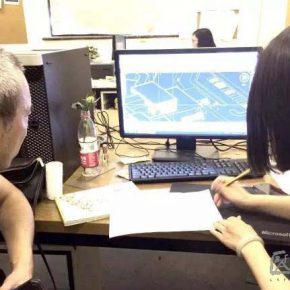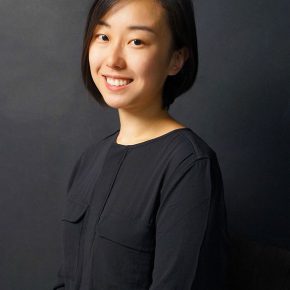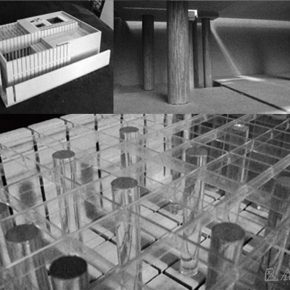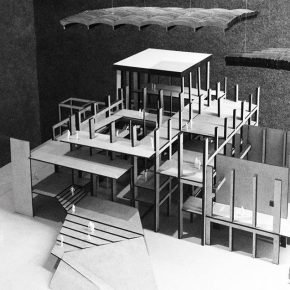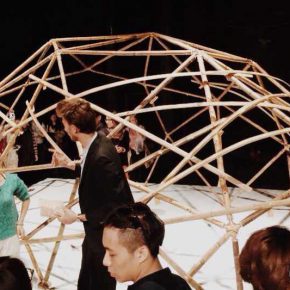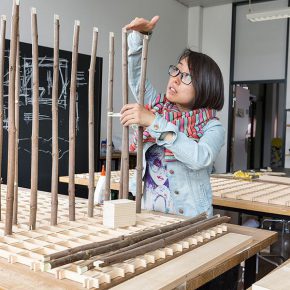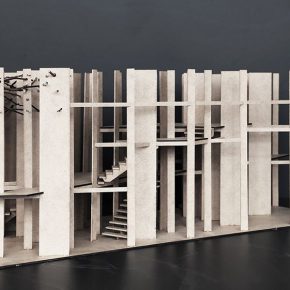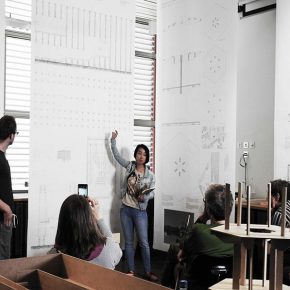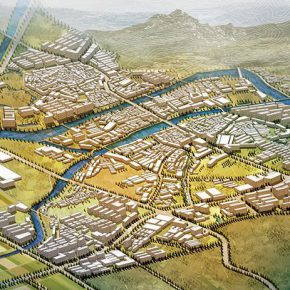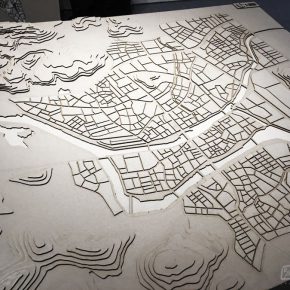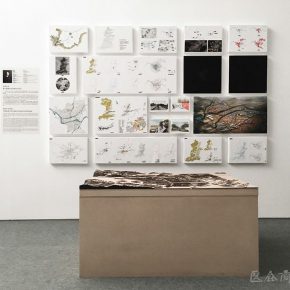
The teaching and training under the synthesized multi-disciplinary educational background is a unique advantage of the discipline of architecture in CAFA, the students don’t only have an excellent professional basis, their imaginary thinking, aesthetic judgment and expressive ability is also reflected in the humanistic and artistic academy features. After learning of the Case Observation program that is specially planned by CAFA ART INFO, the Dean of the School of Architecture Prof. Lyu Pinjing recommended on the graduate Ru Yi from the fourth studio on the architectural direction.
I am glad to be hereAs a graduate of the School of Architecture, majoring in the direction of Architecture research, Ru Yi has lived in the family of CAFA for eight years. Ru Yi loved painting during childhood, from kindergarten, elementary school to junior high school, she had been immersed in painting in her spare time, instead of going to extra tutorial lessons, so she chose painting as her specialty and decided to take the university entrance examination in art. Ru Yi admitted that she passed the first college entrance examination, but she wasn´t happy with the result and so decided to have a second attempt, after she found her main area of expertise, she continued to try. Because Ru studied the sciences in high school, and her mother was engaged in science related work, her rational thinking and analytical capability was her advantage area, she was happy to explore and harvest joys in the process of learning three-dimensional configuration, so that, her direction was gradually clear. In the second year Ru Yi entered herself for the entrance examinations of 13 universities and colleges of art, and she received a qualified notice from the School of Architecture, CAFA.
The majority of CAFA’s students are arts student, so Ru Yi was perturbed and afraid that her creativity was poorer than others at the beginning, and she wasn’t confident in being well integrated into the CAFA family. But the situation gradually improved after Ru entered professional classes, while the School of Architecture has always stressed their skill in actively cultivating students’ learning attitude in independence, participatory, creativity, giving students full freedom, and excavating the different potential of each person, encouraging them to find their own interested creative ideas and unique concepts. Ru Yi began releasing herself, and she recalled the impressed course “Initial Construction” directed by Liu Siyong, which was the first course for the freshman, this course of less than 8 weeks quickly opened her horizon, she had a lot of practice to start her on her own way, Ru said frankly that, “I have always remembered teacher Liu’s words ‘it demands lots of workload’ over the pasteight years.” The workload has not reflected on the repeated and disorder labor, but has helped the designers to accumulate experiences in the practice, to find the optimal solution, to find a new possibility, like encouragement which makes her confident in the following study, “when I face the resistance of the work and study, I rely on this sentence to encourage myself”.
During university, experienced in the training of a variety of program designs, Ru Yi gradually developed the professional quality of a quasi-architect, she is used to “looking, listening, questioning and feeling the pulse to see the structure, looking for a streamline, drawing façade, taking photos of details, counting thenumber of steps, measuring size – choosing eyes and hands to replace themechanized “camera”, studying and accumulating simple notes and hand drawings, which were organized into books. The training methods of CAFA are not simply to teach technology, but to teach people to think, to guide students to find their own direction and approach. She said that she had formed a fine habit during the study in CAFA in recent years, which would be beneficial for life, when she timelessly looked back, she would find the substantial personal learning process and the harvest of growth.
CAFA’s embrace is so warm that I would like to stay here to keep away from the outside noise“The greatest charm of CAFA lies in the unconstrained stage, which is broad and inclusive, ‘organized but undisciplined’”, Ru Yi talked about her true feeling of CAFA, “CAFA’s embrace is so warm that I would like to stay here to keep away from the outside noise.” Ru Yi gradually released herself in the School of Architecture during the period of her 5-year undergraduate programme and she was no longer wedded to awkwardness and strangeness, in her own words that read, “look back at the long-lost status”, “slowly finding my own small world from the outside world”. In 2013, Ru Yi was successfully enrolled as a postgraduate of architectural direction, but the success did not stop her, she also hated her subconscious idle habit, so she continuously tried many different things, such as curatorial assistant, subject assistant, translation, etc., she never rested for almost three years.
When she was a second year postgraduate student, Ru went to Lucerne University of Applied Sciences and Arts in Switzerland as an exchange student. She recalled the beautiful memories when she studied in the small town surrounded by the Alps, and she was impressed by the different teaching methods and design thinking, “five teachers are arranged in a course, not only do the students express their views, but also the teachers warmly debate the discussion. In the last course report, it applied a “poll” to solve a vexed issue, which was very interesting.” Ru said that, “I have chosen a program, the use of wood to build a temporary light tower and I enjoyed the process very much,” the architect who likes handwork was attracted by a large number of carpentry tools and the complete equipment in the wooden workshop, during the exchange period, Ru handcrafted work almost every day in the workshop, constantly trying to find the best way to express the design program. In addition to finishing the basic schoolwork, with the architect’s professional talent Ru Yi also toured many European cities, she visited the Milan Expo, Chapelle de Ronchamp, Reichstagsgebäude in Germany and so on – as she said that, “travel is the best way to narrow the distance between books and practice.”
Graduation is the beginning of setting sail, and I look forward to the unknown thingsRu Yi for her graduation design chose the “The Urban Spatial Space Research Based on the Spatial Syntax” as the theme, which aims at exploring the possibility and effectiveness of “space syntax” applied in a small and medium size, as well as the guiding significance. “Space Syntax” was originated in the 1970s, namely taking the spatial ontology as the research object, and it provides an effective modeling tool to research the relationship between the urban land use function and spatial form. The design takes Yinjiang Town in Ningbo as example, starting from a rational analysis, based on accurate statistical data, then applying theanalysis software of space syntax to get the relationship between the urban use of the situation and urban spatial structure in 2008 and 2015, to capture the features of the evolution of the town in this period, verifying that spatial syntax can be applicable to spatial analysis in the small and medium cities asrepresented by Yinjiang Town, she has successfully tried the quantitative data collection analysis and qualitative architectural analysis, reflecting the positive role of the construction of “digitization”, while it has a positive guiding significance in the planning of small and medium towns in China. After drafting a detailed project, she took full advantage to commit herself to solving the actual architectural problem in China, and her preciseness was praised by teachers, as Prof. Wang Yun from Peking University commented that – “I applaud the expounding that relies on a detailed data and rigorous analysis as I am able to see in the School of Architecture, CAFA”, at the graduation oral examination.
Ru Yi also thanks the encouragement and teaching given by her tutor Prof. Lv Pinjing during the periods of undergraduate and postgraduate study. When it came to reaping rewards from learning, she said sincerely that, “I was brought into the world of architecture in the period of undergraduate study, which allowed me to stretch freely and I learned how to think which is sometimes more important than skills in the 3-year postgraduate study.” For the consideration of architectural design which gradually changes the “bird’s-eye view” to “human’s-eye view”, the observing system started from the perspective of direct human influences the conceived idea and architectural matter, and is “people oriented” which is not an empty talk. Ru Yi said that, “I would like to feel an architect or a site from the perspective of an ordinary person instead of the architect’s.”
In fact, when I contacted Ru Yi, her friends were taking wedding photographs of Ru and her husband, and we blessed the new couple. After graduation, she will go to Germany together with her husband, as to her future plan, she said she does not have a clear plan of the future, and joked that she “might raise cattle?” but she understood her own insistence, “the 8-year stable life in CAFA allows me to begin looking forward to the unknown”, CAFA brings people the courage to not be afraid of the future, which is a valuable calmness, she said that, “with the architectural thinking formed in the School of Architecture, CAFA, I will continue to insist on the direction of an architect, slowly looking for the end.”
Image Courtesy of Ru Yi
Text by Zhang Yizhi, translated by Chen Peihua and edited by Sue/CAFA ART INFO


